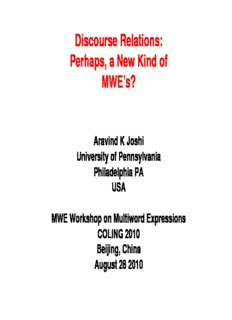
Slides 3 PDF
Preview Slides 3
Discourse Relations: Perhaps, a New Kind of MWE’s? Aravind K Joshi University of Pennsylvania Philadelphia PA USA MWE Workshop on Multiword Expressions COLING 2010 Beijing, China August 28 2010 Outline • What are MWE’s? • A very quick description of the task of annotating discourse relations • Alternate Lexicalizations (AltLex) -- Possibly, a kind of MWE’s serving as discourse relations -- Open, Closed, or Partially Open Class? -- Cross Linguistic Implications • Summary What are MWE’s ? • MWE’s are expressions whose structure and meaning cannot be derived from their component words as they occur independently • MWE’s can be more frequent than their single word paraphrases, for example, single words for elementary spatial relations, e.g., in front of before next to beside (Alternate Lexicalizations) • Fundamentality of expressions as opposed to words, as basic units (Filmore 2003) What are MWE’s ? • MWE’s with figurative meanings, sometimes allowing modifications and variations in sentence forms, e.g., spill some of the beans which beans were spilled? • MWE’s as possibly large non-compositional chunks (semantically or syntactically non-compositional) as single units, thus simplifying -- large scale semantic annotation tasks • Such expressions arise in the task of annotating discourse relations • Should one treat them as certain kinds of MWE’s or not is an open question? A very quick introduction to a discourse annotation project: Penn Discourse Annotation Project (PDTB) WWhhaatt iiss aa ddiissccoouurrssee rreellaattiioonn?? The meaning and coherence of a discourse results partly from how its constituents relate to each other. (cid:131) Reference relations (cid:131) Discourse relations (cid:131) Relation between abstract entities like events, states, and propositions (Abstract Objects (Asher 1993)) (cid:131) E.g., CONTRAST, CAUSE, CONDITIONAL, TEMPORAL (1) She hasn’t played any music since the earthquake hit. (Temporal relation between an event of the earthquake hitting and a state where no music is played by a certain woman) HHooww aarree DDiissccoouurrssee RReellaattiioonnss TTrriiggggeerreedd?? Broadly, two ways in which discourse relations may be declared in text: (cid:131) Lexically: Discourse Relations can be grounded in lexical items. Abstract Objects related by lexically anchored discourse relations can be adjacent or non-adjacent in the text. (2) She has not played any music since the earthquake hit (cid:131) Structurally through Adjacency: Discourse Relations can be triggered by structure underlying adjacency. Such relations have to be inferred (but may be partly supported by text). (3) John left. He was tired. (inference of CAUSAL relation) TThhee PPeennnn DDiissccoouurrssee TTrreeeebbaannkk ((PPDDTTBB)) The PDTB provides annotations of both lexically-triggered discourse relations as well as inferred discourse relations triggered via structural adjacency. Corpus: 2159 Wall Street Journal texts (~1M words) in the Penn Treebank Corpus (Marcus et al., 1993) What is annotated: (cid:131) Discourse relations and their arguments, as their anchoring text spans (inferred relations have a dummy anchor) (cid:131) Semantics of relations, as features (cid:131) Attribution of relations and their arguments, as text spans anchoring attribution phrases, and features capturing the attribution semantics. PPDDTTBB AAnnnnoottaattiioonn OOvveerrvviieeww Relation Types Alternative Explicit Implicit Entity-based No Relation Lexicalizations Connectives Conn. Coherence (NoRel) (AltLex) Relation (EntRel) Discourse Relations Non-Discourse Relations (include annotation for (no annotation for semantics semantics and attribution) and attribution) EExxpplliicciitt CCoonnnneeccttiivveess Explicit connectives are drawn from well-defined syntactic classes: • Subordinating conjunctions (e.g., when, because, although, etc.) (cid:190) The federal government suspended sales of U.S. savings bonds because Congress hasn't lifted the ceiling on government debt. • Coordinating conjunctions (e.g., and, or, so, nor, etc.) (cid:190) The subject will be written into the plots of prime-time shows, and viewers will be given a 900 number to call. • Discourse adverbials (e.g., then, however, as a result, etc.) (cid:190) In the past, the socialist policies of the government strictly limited the size of … industrial concerns to conserve resources and restrict the profits businessmen could make. As a result, industry operated out of small, expensive, highly inefficient industrial units. N.B. Discourse relations have two and only 2 AO arguments: Arg2 is the clause with which connective is syntactically associated Arg1 is the other argument
Description: